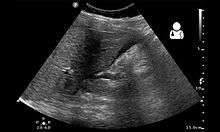Heterotopic pregnancy
A heterotopic pregnancy is a rare[2][3] complication of pregnancy in which both extra-uterine (ectopic pregnancy) and intrauterine pregnancy occur simultaneously.[4] It may also be referred to as a combined ectopic pregnancy, multiple‑sited pregnancy, or coincident pregnancy.
| Heterotopic pregnancy | |
|---|---|
| Ruptured heterotopic pregnancy on ultrasound[1] | |
| Specialty | Obstetrics |
Cause
In a heterotopic pregnancy there is one fertilized ovum which implants normally in the uterus, and one fertilized ovum which implants abnormally, outside of the uterus.
Pathogenesis
In the general population, the major risk factors for heterotopic pregnancy are the same as those for ectopic pregnancy. For women in an assisted reproductive program, there are additional factors: a higher incidence of multiple ovulation, a higher incidence of tubal malformation and/or tubal damage, and technical factors in embryo transfer which may increase the risk for ectopic and heterotopic pregnancy.
Diagnosis

Differential diagnosis
A possible pregnancy must be considered in any woman who has abdominal pain or abnormal vaginal bleeding. A heterotopic pregnancy may have similar signs and symptoms as a normal intrauterine pregnancy, a normal intrauterine pregnancy and a ruptured ovarian cyst, a corpus luteum, or appendicitis. Blood tests and ultrasound can be used to differentiate these conditions.
Management
Heterotopic pregnancy is treated with surgical removal of the ectopic gestation by salpingectomy or salpingostomy. Expectant management has been successfully applied in select cases. Successful salpingocentesis has also been reported.
Prognosis
Extrauterine pregnancies are non-viable and can be fatal to the mother if left untreated. The mortality rate for the extrauterine pregnancy is approximately 35%.
Epidemiology
The prevalence of heterotopic pregnancy is estimated at 0.6‑2.5:10,000 pregnancies.[3] There is a significant increase in the incidence of heterotopic pregnancy in women undergoing ovulation induction. An even greater incidence of heterotopic pregnancy is reported in pregnancies following assisted reproduction techniques such as [iIn vitro fertilization]] (IVF) and gamete intrafallopian transfer (GIFT), with an estimated incidence at between 1 and 3 in 100 pregnancies.[5] If there is embryo transfer of more than 4 embryos, the risk has been quoted as 1 in 45.[5] In natural conceptions, the incidence of heterotopic pregnancy has been estimated to be 1 in 30 000 pregnancies.[5]
References
- "UOTW #9 - Ultrasound of the Week". Ultrasound of the Week. 15 July 2014. Retrieved 27 May 2017.
- Richards, S. R.; Stempel, L. E.; Carlton, B. D. (1982). "Heterotopic pregnancy: Reappraisal of incidence". Am. J. Obstet. Gynecol. 142 (7): 928. PMID 7065071.
- Bello, G. V.; Schonolz, D.; Moshirpur, J.; et al. (1986). "Combined pregnancy: The Mount Sinai experience". Obstet. Gynecol. Surv. 41 (10): 603. PMID 3774265.
- "Archived copy". Archived from the original on 2006-09-27. Retrieved 2008-08-19.CS1 maint: archived copy as title (link)
- Kirk, E.; Bottomley, C.; Bourne, T. (2013). "Diagnosing ectopic pregnancy and current concepts in the management of pregnancy of unknown location". Human Reproduction Update. 20 (2): 250–61. doi:10.1093/humupd/dmt047. PMID 24101604.
External links
| Classification | |
|---|---|
| External resources |